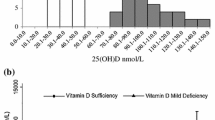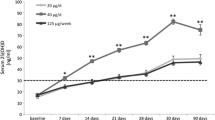Abstract
Summary
Vitamin D, parathyroid hormone levels and calcium absorption was assessed before and after cholecalciferol using Strontium as a surrogate. Increase in 25OHD, lowering of iPTH with no effect on Sr absorption was seen, suggesting the possibility that maximal Ca absorption had already been achieved in these volunteers.
Introduction
This paper discusses the determination of calcium (Ca) absorption, using strontium (Sr) as a surrogate, before and after a single IM injection of vitamin D3 (600,000 IU).
Methods
Baseline serum 25-hydroxyvitamin D (25OHD), Sr, Ca, P, and intact parathyroid hormone (iPTH) were determined in 53 fasting volunteers, followed by administrating (PO) 0.03 mM (4.8 mg/kg) SrCl2 and collecting blood at 0.5, 1 and 4 h to determine the absorption (AUC0→t ) of Sr. Following the initial absorption test, volunteers received a single IM injection of 600,000 IU vitamin D3. Two months later, the fasting serum and the Sr absorption test were repeated, as described above.
Results
The IM injection of vitamin D3 caused a significant increase in fasting 25OHD (from 43.5 ± 19 to 66.1 ± 19.1 nmol/L (p < 0.001)) and a trend toward lower serum iPTH (from 59.8 ± 27.8 to 53 ± 31 ng/L). Fasting serum Ca and P remained unchanged. A higher 25OHD level failed (p = 0.32) to translate into a higher rate of Sr absorption. AUC0→4 h were almost identical before and after the IM injection of vitamin D3.
Conclusion
A single vitamin D3 injection of 600,000 IU significantly increase mean 25OHD concentration and tended to lower iPTH concentrations in volunteers with initially low 25OHD status, suggesting to utilize this simple form of treatment to improve vitamin D status and to have a possible biological effect on Ca homeostasis. However, we found no obvious effect on Sr absorption, suggesting the possibility that maximal vitamin D-dependent Ca absorption had already been achieved in these volunteers at a lower vitamin D status.


Similar content being viewed by others
References
Holick MF (2007) Vitamin D deficiency. N Engl J Med 357(3):266–281
Holick MF, Chen TC (2008) Vitamin D deficiency: a worldwide problem with health consequences. Am J Clin Nutr 87(4):1080S–1086S
Holick MF (2008) Vitamin D and sunlight: strategies for cancer prevention and other health benefits. Clin J Am Soc Nephrol 3(5):1548–1554
Lowe NM, Mitra SR, Foster PC, Bhojani I, McCann JF (2010) Vitamin D status and markers of bone turnover in Caucasian and South Asian postmenopausal women living in the UK. Br J Nutr 103(12):1706–1710
Tahrani AA, Ball A, Shepherd L, Rahim A, Jones AF, Bates A (2010) The prevalence of vitamin D abnormalities in South Asians with type 2 diabetes mellitus in the UK. Int J Clin Pract 64(3):351–355
Khadilkar A, Crabtree NJ, Ward KA, Khadilkar V, Shaw NJ, Mughal MZ (2010) Bone status of adolescent girls in Pune (India) compared to age-matched South Asian and white Caucasian girls in the UK. Osteoporos Int 21(7):1155–1160
Zuberi LM, Habib A, Haque N, Jabbar A (2008) Vitamin D deficiency in ambulatory patients. J Pak Med Assoc 58(9):482–484
Mansoor S, Habib A, Ghani F, Fatmi Z, Badruddin S, Siddiqui I et al (2011) Prevalence and significance of vitamin D deficiency and insufficiency among apparently healthy adults. Clin Biochem 43(18):1431–1435
Heaney RP (2003) Vitamin D depletion and effective calcium absorption. J Bone Miner Res 18(7):1342, author reply 3
Heaney RP, Dowell MS, Hale CA, Bendich A (2003) Calcium absorption varies within the reference range for serum 25-hydroxyvitamin D. J Am Coll Nutr 22(2):142–146
Ross AC, Manson JE, Abrams SA, Aloia JF, Brannon PM, Clinton SK et al (2011) The 2011 report on dietary reference intakes for calcium and vitamin D from the Institute of Medicine: what clinicians need to know. J Clin Endocrinol Metab 96(1):53–58
Dijkgraaf-Ten Bolscher M, Netelenbos JC, Barto R, van Der Vijgh WJ (2000) Strontium as a marker for intestinal calcium absorption: the stimulatory effect of calcitriol. Clin Chem 46(2):248–251
Wasserman RH (1998) Strontium as a tracer for calcium in biological and clinical research. Clin Chem 44(3):437–439
Vezzoli G, Baragetti I, Zerbi S, Caumo A, Soldati L, Bellinzoni P et al (1998) Strontium absorption and excretion in normocalciuric subjects: relation to calcium metabolism. Clin Chem 44(3):586–590
Vezzoli G, Caumo A, Baragetti I, Zerbi S, Bellinzoni P, Centemero A et al (1999) Study of calcium metabolism in idiopathic hypercalciuria by strontium oral load test. Clin Chem 45(2):257–261
Milsom S, Ibbertson K, Hannan S, Shaw D, Pybus J (1987) Simple test of intestinal calcium absorption measured by stable strontium. Br Med J (Clin Res Ed) 295(6592):231–234
Zhang Y, Huo M, Zhou J, Xie S (2010) PKSolver: an add-in program for pharmacokinetic and pharmacodynamic data analysis in Microsoft Excel. Comput Methods Programs Biomed 99(3):306–314
Barger-Lux MJ, Heaney RP, Lanspa SJ, Healy JC, DeLuca HF (1995) An investigation of sources of variation in calcium absorption efficiency. J Clin Endocrinol Metab 80(2):406–411
Barger-Lux MJ, Heaney RP (2002) Effects of above average summer sun exposure on serum 25-hydroxyvitamin D and calcium absorption. J Clin Endocrinol Metab 87(11):4952–4956
Khan AH, Jabbar A, Baig R (2008) Vitamin D deficiency osteomalacia: the continuing challenge. J Coll Physicians Surg Pak 18(10):666
Khan AH, Iqbal R (2009) Vitamin D deficiency in an ample sunlight country. J Coll Physicians Surg Pak 19(5):267–268
Nordin BE, Need AG, Morris HA, O’Loughlin PD, Horowitz M (2004) Effect of age on calcium absorption in postmenopausal women. Am J Clin Nutr 80(4):998–1002
Need AG, Nordin BE (2008) Misconceptions—vitamin D insufficiency causes malabsorption of calcium. Bone 42(6):1021–1024
Nordin BE (2010) Calcium absorption revisited. Am J Clin Nutr 92(4):673–674
Aloia JF, Chen DG, Yeh JK, Chen H (2008) Serum vitamin D metabolites and intestinal calcium absorption efficiency in women. Am J Clin Nutr 92(4):835–840
Need AG, O’Loughlin PD, Morris HA, Coates PS, Horowitz M, Nordin BE (2008) Vitamin D metabolites and calcium absorption in severe vitamin D deficiency. J Bone Miner Res 23(11):1859–1863
Abrams SA, Hicks PD, Hawthorne KM (2009) Higher serum 25-hydroxyvitamin D levels in school-age children are inconsistently associated with increased calcium absorption. J Clin Endocrinol Metab 94(7):2421–2427
Thacher TD, Obadofin MO, O’Brien KO, Abrams SA (2009) The effect of vitamin D2 and vitamin D3 on intestinal calcium absorption in Nigerian children with rickets. J Clin Endocrinol Metab 94(9):3314–3321
Acknowledgments
The authors wish to acknowledge Higher Education Commission of Pakistan for funding the project. In addition, we wish to acknowledge the assistance of Gayle Petty, Director of the Nutrition Evaluation Laboratory at the Jean Mayer USDA Human Nutrition Research Center on Aging at Tufts University in Boston, MA and her staff for use of the direct current plasma emission spectroscope and technical assistance in analysis of the Sr samples.
Conflicts of interest
None.
Author information
Authors and Affiliations
Corresponding author
Additional information
Both Khan A.H. and Rohra D.K. contributed equally.
Rights and permissions
About this article
Cite this article
Khan, A.H., Rohra, D.K., Saghir, S.A. et al. No change in calcium absorption in adult Pakistani population before and after vitamin D administration using strontium as surrogate. Osteoporos Int 24, 1057–1062 (2013). https://doi.org/10.1007/s00198-012-2007-9
Received:
Accepted:
Published:
Issue Date:
DOI: https://doi.org/10.1007/s00198-012-2007-9




